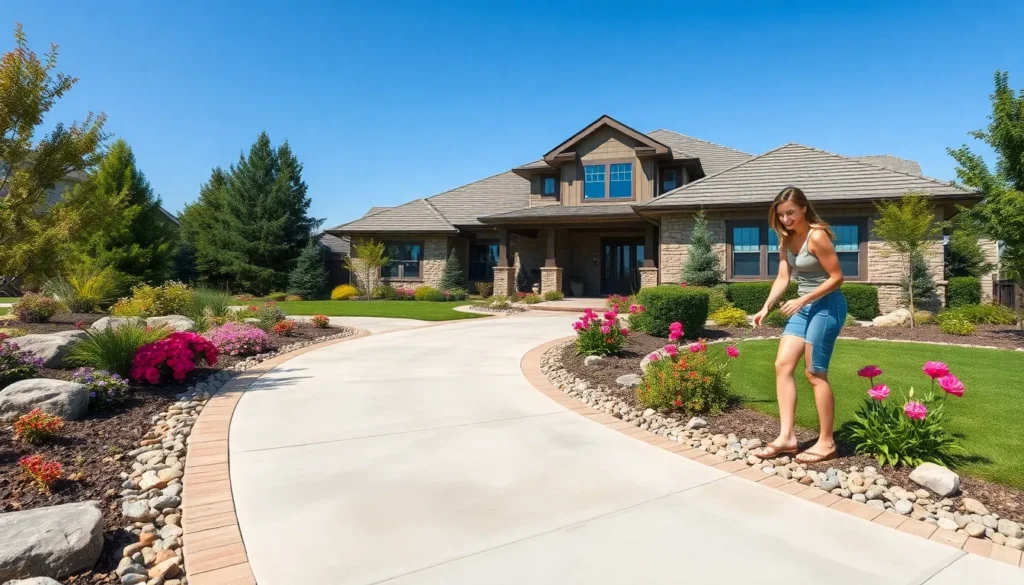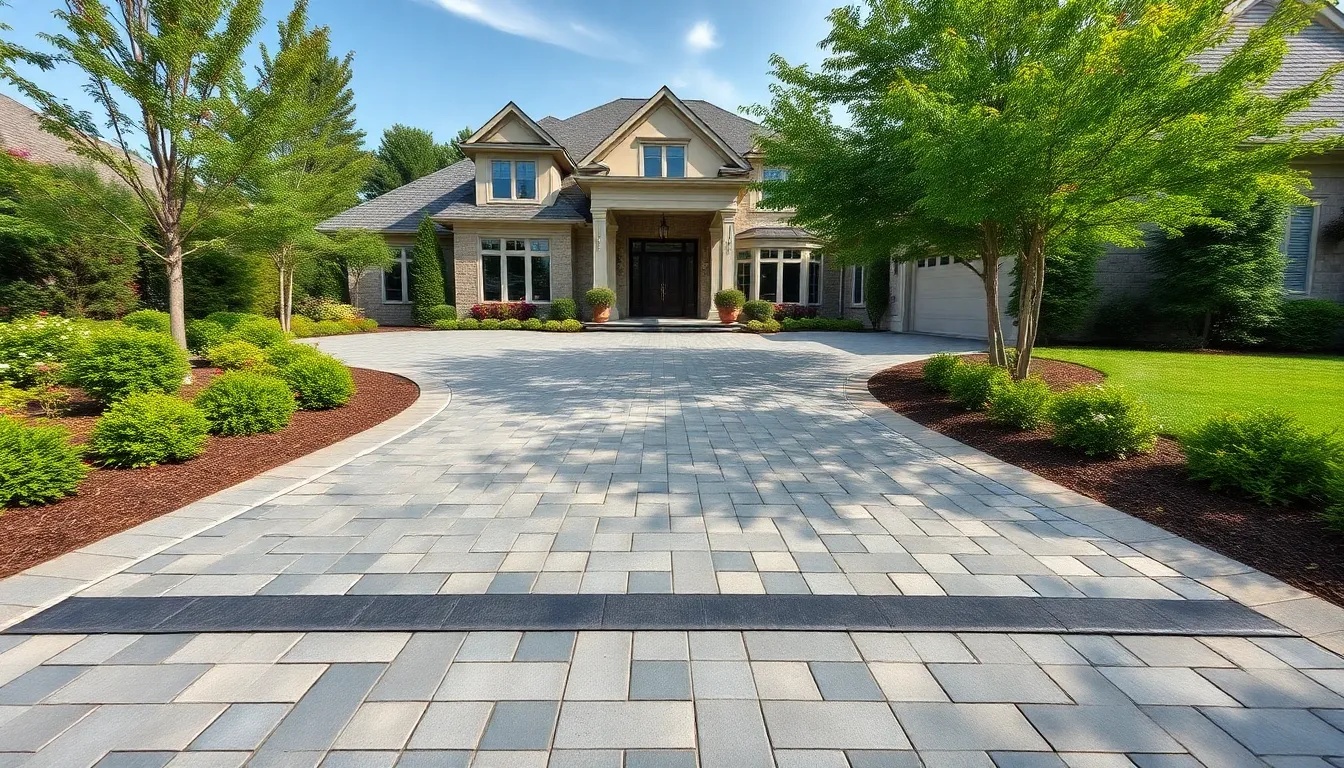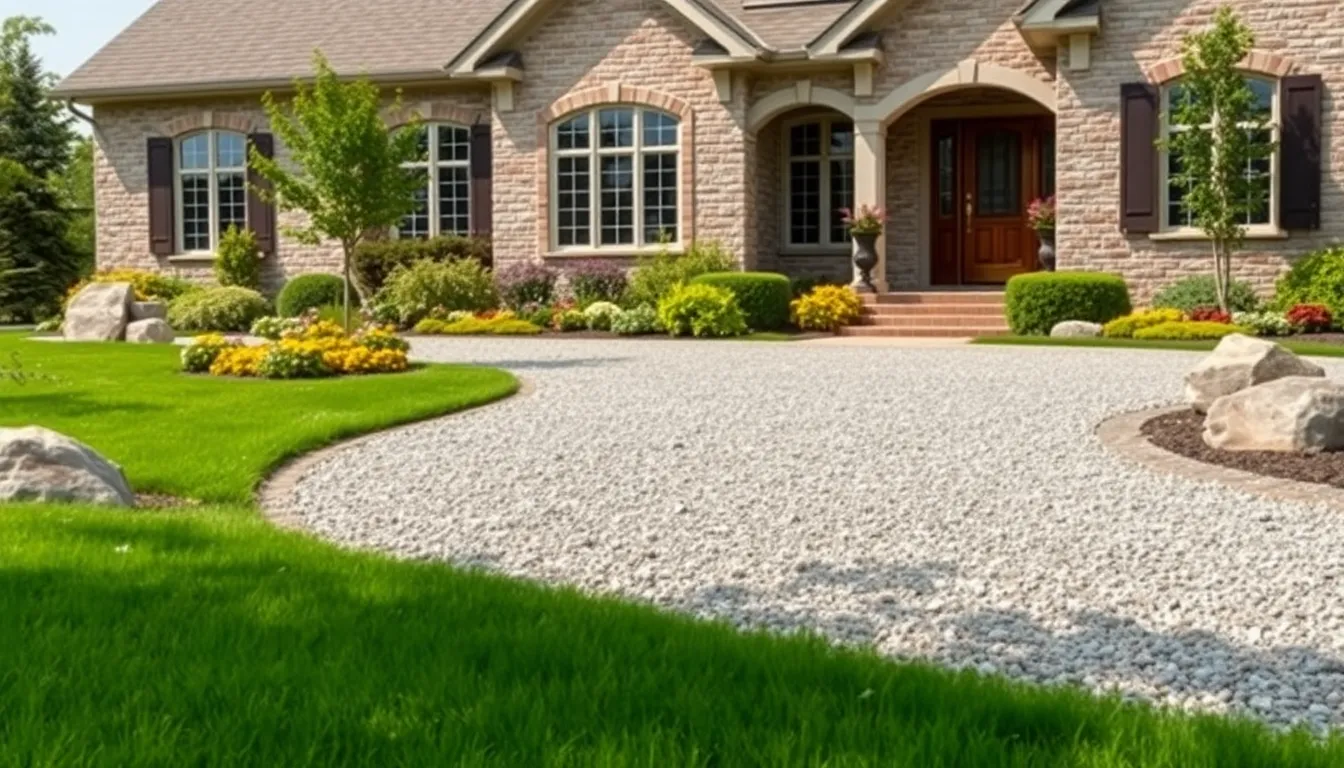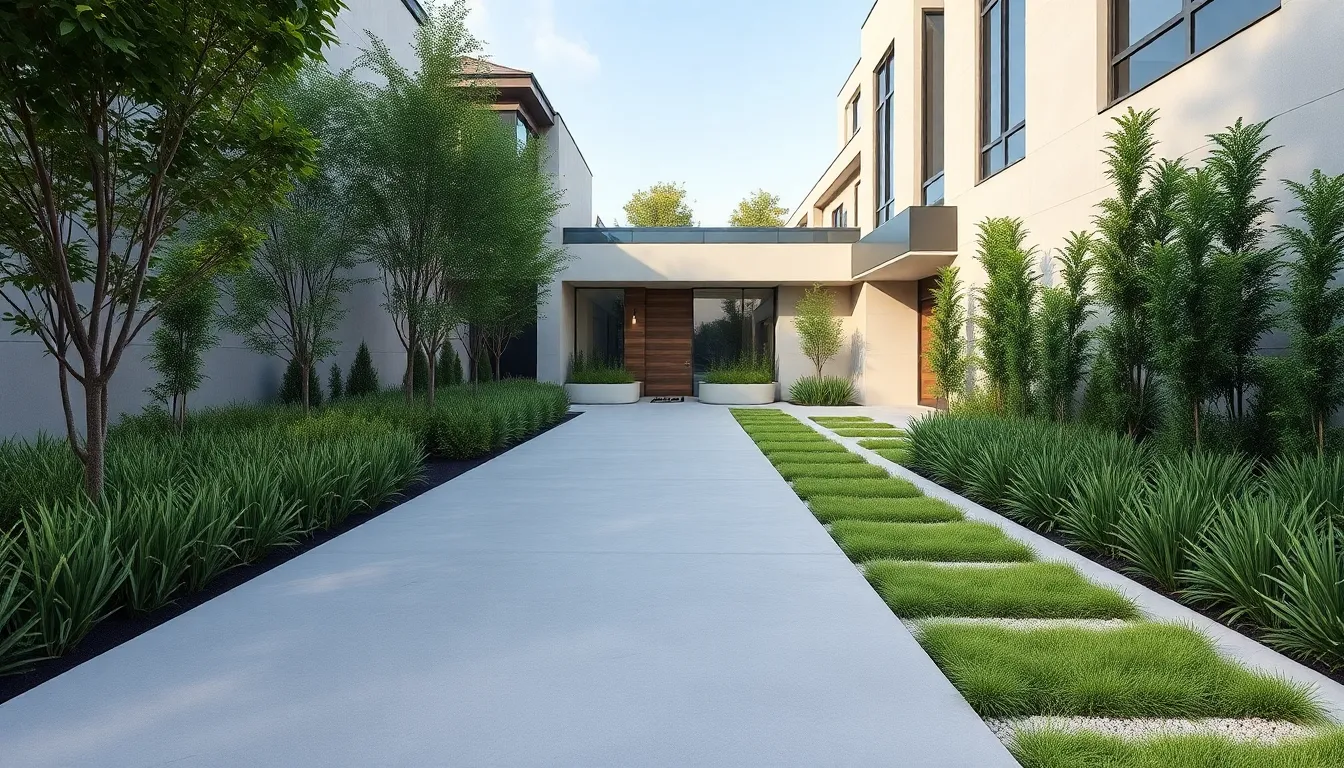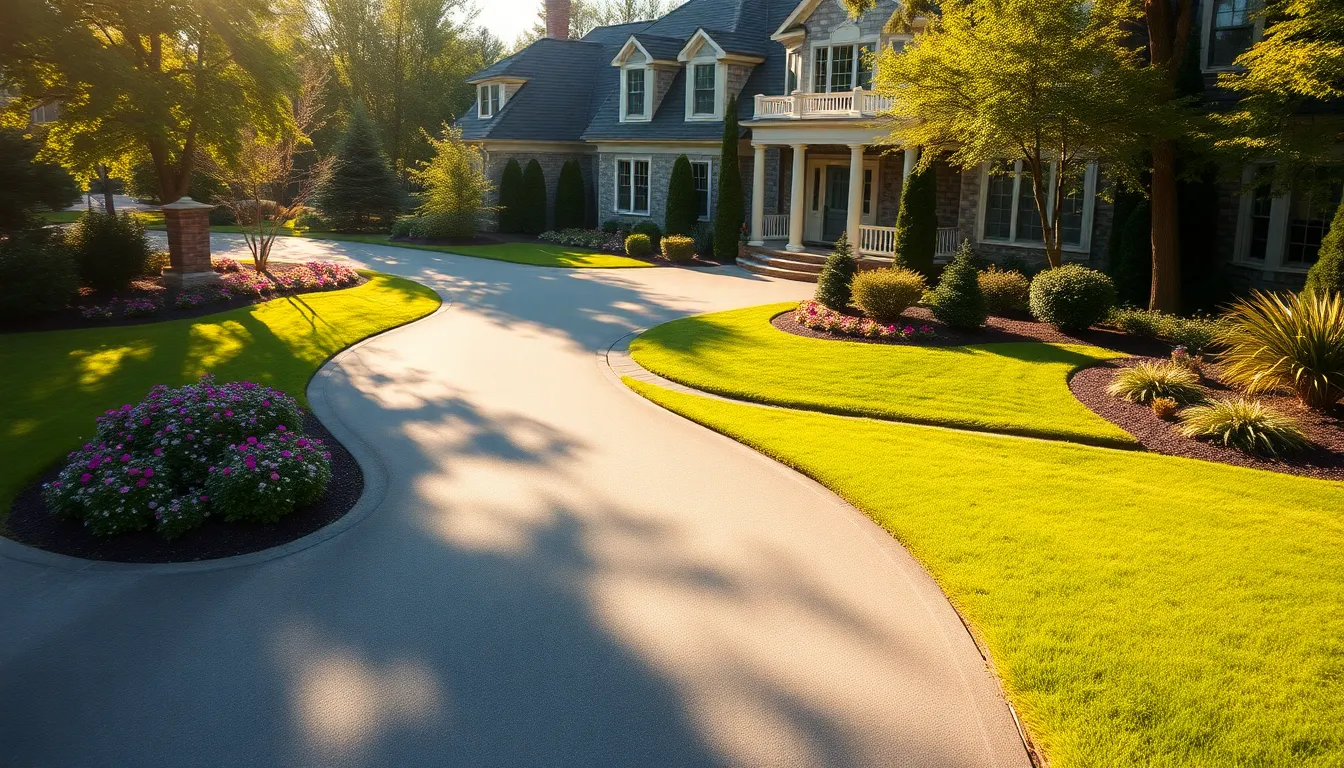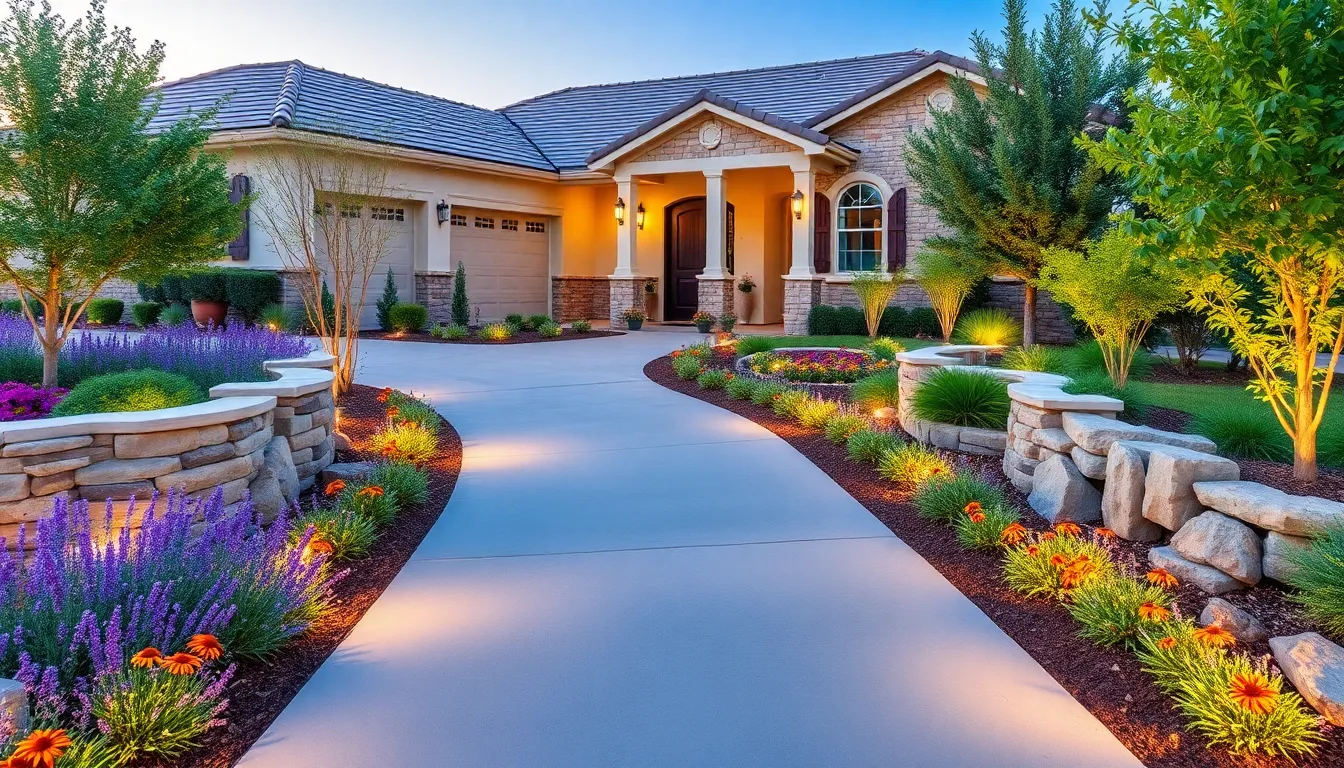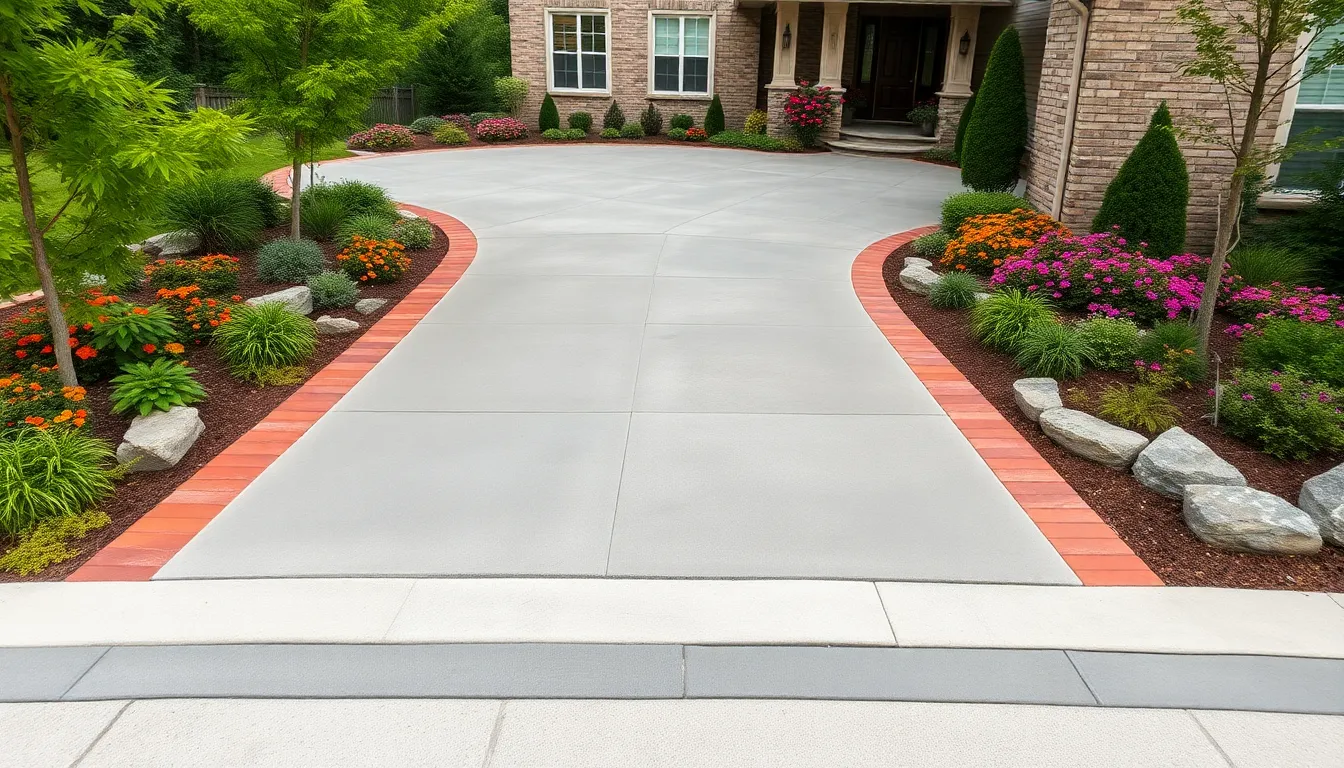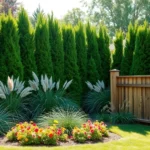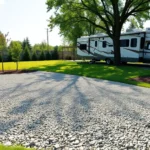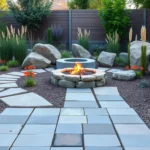Your driveway isn’t just a path to your garage – it’s the first impression visitors get of your home. We’ve all driven past houses where stunning driveways instantly catch our attention and make us wonder about the design choices behind them. The right driveway design can dramatically boost your home’s curb appeal while adding important value to your property.
Whether you’re building a new home or looking to upgrade your existing driveway, we understand that choosing the perfect design feels overwhelming. From classic concrete and elegant pavers to eco-friendly gravel and modern permeable options, the possibilities seem endless.
We’re here to guide you through the most popular and practical front yard driveway ideas that’ll transform your home’s entrance. You’ll discover design options that match your style, budget, and maintenance preferences while creating that wow factor every homeowner dreams of achieving.
Consider Classic Concrete Driveway Designs for Timeless Appeal
Concrete driveways offer enduring beauty and exceptional durability that complement any architectural style. We’ve found these classic designs provide the perfect foundation for creating an impressive front entrance.
Stamped Concrete Patterns
Stamped concrete transforms ordinary driveways into stunning focal points by mimicking expensive materials at a fraction of the cost. Popular patterns include brick, stone, wood plank, and cobblestone designs that add instant character to your home’s exterior. We recommend choosing patterns that complement your home’s architectural features, such as herringbone stamps for traditional homes or slate patterns for contemporary designs.
Professional installation typically costs $8 to $18 per square foot, making stamped concrete an affordable luxury option. The process involves pressing textured mats into wet concrete to create realistic impressions that fool the eye. Popular color combinations include earth tones like sandstone and charcoal for a natural appearance.
Colored Concrete Options
Colored concrete eliminates the plain gray appearance while maintaining concrete’s practical benefits. Integral color mixing produces consistent hues throughout the entire slab, preventing chipping or fading issues common with surface applications. We’ve seen homeowners choose warm terra cotta, elegant charcoal, and classic beige tones that enhance their property’s curb appeal.
Acid staining creates unique mottled effects and deeper color penetration for a more dramatic appearance. This technique works particularly well for contemporary homes seeking sophisticated earth tones. Color hardeners applied during finishing provide additional durability while improving the concrete’s natural strength.
Exposed Aggregate Finishes
Exposed aggregate reveals decorative stones and pebbles within the concrete surface, creating natural texture and visual interest. This finish provides excellent traction in wet conditions while hiding minor stains and wear patterns. We recommend choosing aggregate colors that coordinate with your home’s exterior palette, such as river rock, crushed granite, or recycled glass options.
The process involves removing the top cement layer to expose underlying aggregates, typically done 4 to 6 hours after pouring. Popular aggregate choices include pea gravel for subtle texture, crushed quartz for sparkle effects, and colored stones for vibrant accents. This finish typically adds $2 to $4 per square foot to standard concrete costs.
Explore Natural Stone Driveway Materials for Luxury Living
Natural stone materials elevate front yard driveways to sophisticated status while delivering exceptional durability. These premium options transform ordinary entrances into stunning luxury features that enhance property value.
Granite Pavers
Granite pavers represent the pinnacle of luxury driveway materials with their exceptional durability and versatile aesthetic appeal. These dense stone options withstand heavy vehicle traffic and severe weather conditions, making them ideal for long-lasting installations. We find granite’s naturally textured surface provides excellent traction in wet conditions, significantly improving safety for homeowners and visitors.
Available colors include classic gray, rich black, warm browns, and distinctive speckled patterns that add visual interest to any front yard design. Various sizes and finishes allow for creative arrangement in multiple patterns such as running bond or elegant fan designs. Granite pavers require minimal maintenance while resisting fading, making them both practical and luxurious for discerning homeowners.
Limestone Slabs
Limestone delivers a softer, more traditional appearance that complements various architectural styles from contemporary to classic designs. This durable material comes in beautiful shades ranging from creamy whites to sophisticated deep grays. We appreciate limestone’s lightly textured surface, which provides reliable traction while contributing to a timeless aesthetic appeal.
Cutting limestone into different shapes allows for creative driveway designs that showcase unique patterns and layouts. Heat reflective properties make limestone particularly suitable for warm climate installations. Regular sealing protects against stains and weathering, ensuring long-term durability and maintaining the stone’s natural beauty over time.
Flagstone Arrangements
Flagstone creates inviting and distinctive driveway surfaces through its irregular shapes and naturally varied textures. Thoughtful arrangements produce a rustic yet elegant look that significantly enhances curb appeal for luxury homes. Natural grooves and surface variations provide excellent traction while offering unique visual character.
Different stone types including sandstone, slate, and limestone provide diverse color palettes and finishes suited for luxury home exteriors. We find flagstone’s organic appearance works exceptionally well with landscaping elements, creating seamless transitions between hardscape and natural features. Proper installation maximizes both the aesthetic impact and functional benefits of these stunning natural stone arrangements.
Discover Gravel Driveway Solutions for Budget-Friendly Beauty
Gravel driveways offer an exceptional combination of affordability, versatility, and natural charm that makes them increasingly popular among homeowners seeking cost-effective front yard answers. We’ll explore the most effective gravel options that deliver both aesthetic appeal and practical functionality.
Crushed Stone Varieties
Crushed stone creates the foundation for durable, stable driveways through its angular design that naturally locks together for superior traction. Limestone stands out as the most popular choice, offering classic white and gray tones that complement traditional home exteriors. Granite provides exceptional durability with rich colors ranging from deep grays to warm browns, making it ideal for high-traffic areas. Trap rock delivers outstanding strength and comes in darker hues that create striking contrast against lighter home facades.
Each crushed stone type provides excellent drainage capabilities, preventing water accumulation and reducing erosion risks in your front yard. Colors vary significantly across stone types, allowing you to match your driveway with existing landscaping themes or architectural elements. Installation costs remain consistently lower than concrete alternatives, typically ranging from $1.50 to $3.00 per square foot depending on stone type and local availability.
Pea Gravel Installations
Pea gravel consists of smooth, rounded stones approximately 1/4 inch in diameter that create a gentle, walkable surface perfect for residential driveways. Installation requires minimal expertise, needing only a properly prepared base layer and effective edging to contain the stones within designated boundaries. We recommend using metal or plastic edging strips to prevent gravel migration onto lawns and sidewalks.
Color options include pristine white, warm tan, rich brown, and attractive mixed palettes that coordinate beautifully with garden beds and pathways. Maintenance involves occasional raking to redistribute stones and periodic replenishment every 2-3 years due to natural displacement. Costs typically run between $1.25 to $2.50 per square foot, making pea gravel one of the most budget-friendly driveway materials available.
Decorative Rock Combinations
Combining different gravel types creates visually striking patterns and textures that transform your driveway into a industry feature. Mixing crushed stone borders with pea gravel centers produces defined edges while maintaining the soft interior appeal that many homeowners prefer. River rocks integrated with traditional gravel create natural-looking accents that blend seamlessly with planted areas and outdoor living spaces.
Contrast techniques using light and dark stones establish dramatic visual interest without requiring additional materials or complex installation procedures. Border applications allow you to incorporate decorative elements like colored glass chips or polished stones for unique personalization. Creative combinations can include herb plantings or succulent installations along driveway edges, creating an eco-friendly approach that enhances both functionality and curb appeal.
We suggest installing proper weed barriers beneath decorative combinations to minimize maintenance requirements while ensuring long-term aesthetic appeal. Preparation involves creating a well-graded base with compacted crushed stone foundation to prevent rutting and extend the lifespan of your decorative rock investment.
Embrace Modern Permeable Paving for Eco-Conscious Homes
Eco-conscious homeowners are increasingly turning to permeable paving answers that combine environmental responsibility with stunning curb appeal. These innovative driveway options allow water to naturally filter through surfaces, reducing runoff while creating sophisticated entrances that complement modern home designs.
Permeable Concrete Systems
Permeable concrete systems revolutionize traditional driveways by incorporating special mixtures that allow water penetration through the surface. This innovative material prevents puddle formation and flooding while maintaining the durability homeowners expect from concrete surfaces. Clean, sleek appearances make permeable concrete an ideal match for contemporary and minimalist home designs.
Load-bearing capabilities ensure these surfaces handle vehicle traffic without compromising structural integrity. Maintenance requirements involve periodic cleaning to prevent pore clogging, but the overall upkeep remains manageable for most homeowners. Installation costs typically run higher than traditional concrete, yet the long-term environmental benefits and reduced stormwater management issues often justify the investment.
Porous Asphalt Applications
Porous asphalt delivers the familiar look and feel of traditional asphalt while addressing critical stormwater management needs. High void content within the material creates pathways for water infiltration, making this option both practical and environmentally conscious. Flexibility and resilience characterize porous asphalt surfaces, providing comfortable driving experiences while supporting sustainable drainage practices.
Weather resistance makes porous asphalt particularly suitable for regions with varying climate conditions. Installation processes mirror traditional asphalt methods, though specialized equipment ensures proper void ratios for optimal water penetration. Cost considerations often favor porous asphalt over other permeable options, making it accessible for homeowners seeking sustainable answers within moderate budgets.
Grass Pavers Integration
Grass pavers create stunning “driveable garden” effects by combining hard paving materials with living ground cover growing through designed spaces. This integration transforms driveways into green landscapes that reduce heat island effects while maintaining full vehicle functionality. Visual appeal increases dramatically as grass or low-growing plants soften hardscape elements and enhance overall curb appeal.
Urban settings particularly benefit from grass paver systems, where driveways occupy important front yard portions that can blend seamlessly with decorative plantings. Texture and color variations emerge naturally as different plant species establish within the paver grid system. Maintenance involves both hardscape care and plant management, though drought-resistant varieties minimize water requirements and upkeep demands.
Design Curved Driveways to Enhance Your Home’s Character
Curved driveways transform your home’s entrance from merely functional to magnificently welcoming. These flowing designs create visual interest while improving your property’s overall aesthetic appeal.
Sweeping Entrance Curves
Sweeping curved driveways create a graceful arc from the street to your garage or front door, offering a smooth and elegant approach to your home. This design softens rigid architectural lines while adding an inviting flow that welcomes visitors with style. Landscaping elements like flower beds, shrubs, and trees positioned along the curve enhance visual interest and frame your entrance beautifully.
Benefits of sweeping curves include:
- Natural transition from public street to private residence
- Opportunity for strategic industry placement
- Reduced harsh angles that complement various home styles
- Enhanced visual depth that makes properties appear larger
Circular Driveway Layouts
Circular driveways make a distinct, luxurious statement while providing practical benefits for vehicle circulation. You’ll never need to back out of your driveway again, making this layout especially practical for larger lots where space allows for grand entrances. Central focal points such as gardens, fountains, or sculptures often anchor these designs, boosting aesthetic appeal significantly.
Key advantages of circular layouts:
- Easy vehicle turnaround without reversing
- Multiple parking spaces for guests
- Impressive curb appeal that increases property value
- Central landscaping opportunities for year round beauty
S-Curve Configurations
S-curve driveways add ever-changing and playful elements to your front yard through two gentle curves flowing in opposite directions. This serpentine shape breaks up driveway space naturally, making it feel less utilitarian and more integrated with your industry design. Narrow or irregularly shaped front yards benefit particularly from this configuration, as it maximizes usable space while creating interesting planting opportunities along the edges.
- Maximizes space efficiency in challenging lot shapes
- Creates natural rhythm and movement
- Provides multiple landscaping zones for varied plantings
- Reduces visual impact of large paved surfaces
Incorporate Landscaping Elements Along Your Driveway Borders
Strategic landscaping along driveway borders transforms your entrance from a simple pathway into a stunning focal point. These thoughtful additions enhance both curb appeal and functionality while creating seamless transitions between hardscape and industry elements.
Planted Borders and Edges
Drought-tolerant plants form the foundation of low-maintenance driveway landscaping that thrives year-round. Lavender, black-eyed Susans, and native flowering shrubs deliver consistent color while requiring minimal water and care. Perennial combinations create ever-changing seasonal displays when you mix evergreens like hellebores with flowering options such as hydrangeas and Pieris japonica.
Strategic plant placement ensures visual impact throughout all seasons, especially in challenging shaded areas near your home. Multiple planters positioned at your driveway entrance establish a welcoming visual break from street views. Layered planting beds incorporate varying heights and textures, from ground-covering perennials to medium-height shrubs, creating depth and professional polish along your driveway edges.
Decorative Lighting Features
LED path lights illuminate driveway borders while dramatically improving nighttime safety and curb appeal. These energy-efficient fixtures guide drivers safely along your driveway edges without overwhelming your industry design. Uplighting techniques showcase your carefully selected trees and shrubs, creating sophisticated shadow patterns that highlight your landscaping investments after dark.
Built-in paver lighting integrates seamlessly into your driveway surface, providing subtle illumination that defines pathways without cluttering your borders. Strategic placement of these fixtures creates an elegant nighttime effect that enhances your home’s architectural features. Accent lighting positioned near key industry elements draws attention to seasonal plantings and decorative features, extending your driveway’s visual appeal well into evening hours.
Retaining Wall Accents
Natural stone retaining walls provide essential structural support on sloped terrain while adding sophisticated architectural interest to your driveway borders. Brick and stone materials create durable boundaries that complement various home styles and withstand weather extremes. Terraced planting opportunities emerge from retaining wall construction, allowing you to incorporate multiple levels of landscaping that add visual depth and planting variety.
Softening techniques using creeping plants and small shrubs transform hard retaining wall surfaces into integrated industry features. These living accents reduce the stark appearance of stone or brick while maintaining the wall’s structural integrity. Decorative edging materials such as flagstone, pavers, or brick create clean separation lines between your driveway and surrounding lawn or garden beds, preventing grass encroachment while delivering a professionally finished appearance.
Plan Multi-Material Combinations for Visual Interest
Combining different materials in our driveway design creates texture contrast and visual depth that transforms an ordinary entrance into a stunning focal point. Multi-material approaches allow us to balance durability with aesthetic appeal while working within various budget constraints.
Concrete and Stone Pairings
Concrete paired with natural stone delivers sophisticated elegance that balances modern functionality with timeless charm. We can use concrete as our primary surface while incorporating stone elements as borders or accent features to define the driveway’s shape and add organic texture.
Large stone slabs embedded within concrete create striking stepping stone effects that guide visitors toward our entrance. Stone pavers as edging materials provide clean lines and natural variation that complement any architectural style. This combination offers exceptional durability while bringing warmth through the stone’s unique patterns and colors.
Maintenance remains minimal with concrete and stone pairings since both materials resist weather damage and wear. We’ll find this approach particularly effective for contemporary homes where clean lines meet natural elements.
Gravel and Brick Accents
Gravel driveways gain remarkable character when we incorporate brick accents that provide structure and visual interest. Brick borders outline gravel areas to create neat, finished edges that prevent material migration while adding architectural detail.
Alternating strips of gravel and brick create ever-changing patterns that transform simple aggregate into an eye-catching design element. This combination works exceptionally well for traditional and cottage style homes where rustic charm meets structured detail.
Drainage benefits increase significantly with gravel and brick combinations since both materials allow water infiltration. We can create intricate patterns using different gravel colors separated by brick dividers for maximum visual impact. Installation costs remain affordable while delivering premium appearance that enhances our home’s curb appeal.
Asphalt with Decorative Borders
Asphalt driveways gain custom appeal through decorative borders that elevate their standard appearance into customized design statements. Stone borders add sophistication while maintaining asphalt’s practical durability and economical installation.
Stamped concrete borders introduce patterns and textures that complement our landscaping while providing clear driveway definition. Brick edging creates classic charm that works beautifully with colonial and traditional architecture styles. We can incorporate mosaic patterns along borders to introduce personality and coordinate with our home’s exterior colors.
Permeable plantings between border elements soften the hardscape appearance while improving sustainability. This approach retains asphalt’s weather resistance and smooth driving surface while adding the visual interest that makes our entrance memorable.
Consider Maintenance Requirements for Long-Term Success
We need to plan for ongoing care to preserve both function and curb appeal of our driveway investment. Smart maintenance planning protects our investment while keeping repair costs manageable over time.
Seasonal Care Schedules
Spring and fall inspections form the backbone of effective driveway maintenance. We should examine our driveways twice yearly to identify small fissures or drainage problems before they escalate into costly repairs. Clearing drainage trenches becomes essential during these seasonal checks to ensure slopes channel water properly and prevent pooling that can damage surfaces.
Winter care requires special attention to prevent surface damage from harsh weather conditions. We must avoid using rock salt on our driveways and opt for sand instead to maintain surface integrity while providing traction. Sand protects both our driveway materials and the surrounding environment from chemical damage.
Weekly maintenance throughout all seasons keeps our driveways in optimal condition. Sweeping or blowing off debris like leaves and grit reduces wear patterns and prevents staining. Regular removal of organic matter also prevents moisture retention that can lead to surface deterioration.
Gravel driveways need seasonal attention after heavy rains or winter thaw when displacement occurs. We should level uneven areas and add fresh gravel to replace stones that have shifted or been carried away by water runoff.
Repair and Restoration Needs
Concrete crack repair requires immediate attention to prevent moisture infiltration and freeze damage. We must seal small cracks early using appropriate patch filler for wider gaps to maintain structural integrity. Edge deterioration poses particular risks since these areas are the weakest points and most susceptible to damage from vehicles or expanding tree roots.
Professional intervention becomes necessary when we encounter potholes or important sinking in our driveways. These symptoms indicate deeper structural issues that require expert assessment and specialized repair techniques. Early detection through regular inspections helps us address problems before they require complete driveway replacement.
Gravel maintenance typically involves simpler restoration needs compared to solid surfaces. We can easily address displaced stones, uneven surfaces, and thin spots by adding fresh material and leveling affected areas. Most gravel repairs fall within the capability of average homeowners with basic tools.
Cost-Effective Upkeep Strategies
Preventive measures significantly reduce long term maintenance expenses for our driveways. We should backfill edges of concrete driveways with dirt to reinforce vulnerable areas and reduce premature cracking. Avoiding repeated parking in the same spots, especially on concrete edges, prevents stress damage that leads to costly repairs.
Routine cleaning maintains surface quality while preventing expensive restoration needs. We must promptly clean stains using appropriate methods, such as applying absorbents like kitty litter for oil spills before they penetrate surface materials. Regular debris removal prevents organic matter from breaking down and staining our driveways.
Material exact strategies maximize the lifespan of different driveway types within our budgets. Gravel driveways require periodic replenishing of 1 to 2 inches of new material every two to three years to maintain smoothness and prevent runoff issues. Concrete surfaces benefit from monitoring crack development and addressing edge weakness before major repairs become necessary.
Strategic maintenance timing helps us spread costs throughout the year rather than facing large unexpected expenses. We can schedule routine care during favorable weather conditions and address minor issues before they compound into major problems requiring professional intervention.
Conclusion
Transforming your front yard driveway doesn’t have to be overwhelming when you understand your options. We’ve explored materials ranging from budget-friendly gravel to luxurious natural stone and innovative permeable answers that benefit both your home and the environment.
The key lies in matching your driveway choice to your home’s architectural style budget and maintenance preferences. Whether you’re drawn to the timeless appeal of stamped concrete the natural beauty of flagstone or the eco-friendly benefits of permeable pavers each option offers unique advantages.
Remember that your driveway investment extends beyond the initial installation. Regular maintenance and thoughtful landscaping integration will ensure your entrance continues making a positive impression for years to come. With proper planning your new driveway will enhance both your home’s curb appeal and property value.
Frequently Asked Questions
What are the most popular driveway materials for homeowners?
The most popular driveway materials include concrete, pavers, gravel, and natural stone. Concrete offers durability and versatility with options like stamped patterns and colored finishes. Pavers provide a premium look with easy maintenance. Gravel driveways are budget-friendly and offer natural charm. Natural stone materials like granite, limestone, and flagstone deliver luxury appeal with exceptional longevity.
How much does it cost to install different types of driveways?
Driveway installation costs vary significantly by material. Gravel driveways are the most budget-friendly option, while concrete offers mid-range pricing with good value. Natural stone materials like granite and limestone represent premium investments but provide exceptional durability. Permeable paving systems may have higher upfront costs but offer long-term environmental benefits and potential utility savings.
What are the benefits of permeable driveway materials?
Permeable driveway materials offer excellent environmental benefits by allowing water to filter through surfaces, preventing flooding and reducing stormwater runoff. These eco-friendly options include permeable concrete, porous asphalt, and grass pavers. They help manage drainage naturally, reduce heat island effects, and can lower municipal stormwater fees while maintaining attractive curb appeal.
How do I maintain my driveway for long-term durability?
Regular maintenance includes seasonal inspections in spring and fall to identify potential issues early. Weekly cleaning removes debris and prevents staining. Winter care involves proper snow removal and avoiding harsh chemicals. Address concrete cracks immediately to prevent expansion. For gravel driveways, periodic raking and adding fresh material maintains appearance and functionality.
Can I combine different materials in my driveway design?
Yes, combining materials creates visual interest and texture contrast. Popular combinations include concrete with natural stone accents, gravel driveways with brick borders, and asphalt with decorative edging. Mixed materials allow for creative design expressions while potentially reducing costs by using premium materials strategically as accents rather than for the entire surface area.
What landscaping elements work best with driveways?
Effective driveway landscaping includes drought-tolerant plants for low maintenance, decorative lighting for safety and curb appeal, and natural stone retaining walls for structural support. Border plantings soften hard surfaces while LED path lights enhance nighttime visibility. Strategic plant placement creates year-round visual interest without interfering with vehicle access or maintenance requirements.
Are curved driveways better than straight ones?
Curved driveways offer several advantages including enhanced visual appeal, softer architectural lines, and improved traffic flow. Options include sweeping entrance curves, circular layouts for better vehicle circulation, and S-curve configurations for challenging lot shapes. While potentially more expensive to install, curved designs create a more welcoming entrance and can increase property value significantly.
How do I choose the right driveway design for my home’s style?
Consider your home’s architectural style, existing landscape, and budget when selecting driveway materials. Traditional homes pair well with natural stone or brick, while modern homes suit concrete or permeable materials. Factor in maintenance requirements, local climate conditions, and desired curb appeal level. Professional consultation can help match materials to your specific style and functional needs.

